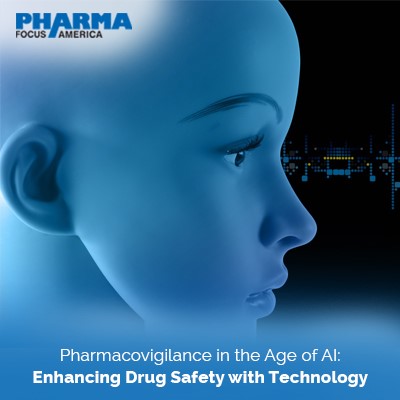
AI is revolutionizing pharmacovigilance by enhancing drug safety through advanced technologies like machine learning and natural language processing. These innovations enable efficient, accurate detection of adverse drug reactions, timely interventions, and comprehensive data analysis. Despite challenges, AI-driven pharmacovigilance promises improved patient outcomes and proactive risk management in healthcare.

Pharmacovigilance, the science of detecting, assessing, understanding, and preventing adverse effects or any other drug-related problems, is a critical component of healthcare. With the advent of artificial intelligence (AI), the landscape of pharmacovigilance is rapidly evolving. AI offers unparalleled opportunities to enhance drug safety, streamline processes, and provide more accurate and timely insights into drug-related risks. This article delves into the transformative role of AI in pharmacovigilance, exploring its benefits, challenges, key technologies, and future trends.
AI technologies, including machine learning (ML), natural language processing (NLP), and data mining, are revolutionizing pharmacovigilance by enabling more efficient and accurate detection of adverse drug reactions (ADRs). These technologies can analyze vast amounts of data from various sources, including electronic health records (EHRs), social media, clinical trials, and spontaneous reporting systems, to identify patterns and signals that might indicate potential drug safety issues.
1. Machine Learning (ML):ML algorithms can learn from historical data to predict future adverse events. By training models on large datasets, ML can identify subtle patterns and correlations that might be missed by traditional methods. This predictive capability is crucial for proactive pharmacovigilance, allowing for early intervention and mitigation of potential risks.
2. Natural Language Processing (NLP):NLP enables the extraction and analysis of unstructured data from various text sources such as medical literature, social media posts, and patient reports. By understanding and interpreting human language, NLP can identify mentions of ADRs and contextual information that might be relevant for pharmacovigilance.
3. Data Mining and Signal Detection: Advanced data mining techniques can sift through large datasets to detect signals of ADRs. These techniques can identify associations between drugs and adverse events, even when the events are rare or the signals are weak. Signal detection algorithms can prioritize these signals for further investigation by pharmacovigilance professionals.
Enhanced Efficiency - AI can automate many routine tasks in pharmacovigilance, such as case processing, data entry, and report generation. This automation reduces the workload on human resources, allowing them to focus on more complex and value-added activities.
Improved Accuracy - AI algorithms can process and analyze data with high accuracy, reducing the risk of human error. This precision ensures that potential safety signals are not overlooked and that false positives are minimized.
Timely Detection of ADRs - AI enables real-time monitoring and analysis of data, leading to the timely detection of ADRs. Early detection allows for quicker responses, which can prevent widespread harm and improve patient safety.
Comprehensive Data Analysis - AI can integrate and analyze data from diverse sources, providing a more holistic view of drug safety. This comprehensive analysis can uncover insights that might be missed when data is considered in isolation.
Data Quality and Availability:The effectiveness of AI depends on the quality and completeness of the data it analyzes. Inconsistent, incomplete, or biased data can lead to inaccurate results. Ensuring high-quality data is a significant challenge for AI-driven pharmacovigilance.
Regulatory and Ethical Considerations:The use of AI in pharmacovigilance raises important regulatory and ethical questions. Regulatory frameworks need to evolve to address issues such as algorithm transparency, data privacy, and the accountability of AI systems. Ensuring that AI tools comply with regulatory standards is critical for their adoption and effectiveness.
Integration with Existing Systems: Integrating AI technologies with existing pharmacovigilance systems and workflows can be complex. It requires significant investment in infrastructure, training, and change management to ensure seamless integration and adoption.
Interpreting AI Results:While AI can identify potential safety signals, interpreting these results requires human expertise. Pharmacovigilance professionals need to understand how AI algorithms work and how to validate and act on their findings. This collaboration between AI and human experts is essential for effective pharmacovigilance.
Personalized Medicine:AI has the potential to advance personalized medicine by identifying individual patient characteristics that influence drug safety. By analyzing genetic, environmental, and lifestyle factors, AI can help tailor pharmacovigilance to specific patient populations, improving drug safety and efficacy.
Predictive Analytics:Future AI tools will increasingly focus on predictive analytics, forecasting potential ADRs before they occur. These predictive models can guide clinical decision-making, risk management, and regulatory actions, enhancing the overall safety of drug therapies.
Blockchain Integration:Integrating blockchain technology with AI can enhance data security, transparency, and traceability in pharmacovigilance. Blockchain can ensure the integrity of data used by AI algorithms, providing a reliable foundation for drug safety assessments.
Global Collaboration:AI can facilitate global collaboration in pharmacovigilance by enabling the sharing and analysis of data across borders. International collaboration can lead to more comprehensive safety assessments and a better understanding of ADRs in diverse populations.
Continuous Learning Systems: AI systems in pharmacovigilance will evolve into continuous learning systems that adapt and improve over time. These systems will incorporate new data, refine their models, and enhance their predictive capabilities, ensuring that pharmacovigilance remains responsive to emerging drug safety challenges.
AI is poised to transform pharmacovigilance, offering unprecedented opportunities to enhance drug safety. By leveraging technologies such as machine learning, natural language processing, and data mining, AI can improve the efficiency, accuracy, and timeliness of pharmacovigilance activities. However, realizing the full potential of AI in this field requires addressing challenges related to data quality, regulatory compliance, system integration, and human-AI collaboration. As the technology continues to advance, AI-driven pharmacovigilance will play a crucial role in ensuring the safety and efficacy of drug therapies, ultimately improving patient outcomes and public health.
By embracing the capabilities of AI, the pharmacovigilance community can proactively identify and mitigate drug-related risks, paving the way for safer and more effective medical treatments in the age of technology.